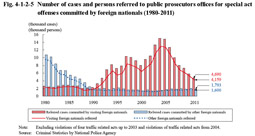2 Special act offenses
Fig. 4-1-2-5 shows the number of cases and persons referred to public prosecutors for special act offenses (excluding violations of traffic related acts (limited to violations of four traffic related acts up to 2003); hereinafter the same in this subsection) committed by visiting and other foreign nationals (from 1980). The number of cases and persons referred to public prosecutors for special act offenses committed by visiting foreign nationals both reached a record high level in 2004, but then started to decrease, and were 4,690 cases (down 18.9% from the previous year) and 4,159 persons (down 19.2% (id.)) in 2011, respectively. From 1990 both the number of cases and number of persons referred to public prosecutors for special act offenses were larger with visiting foreign nationals than other foreign nationals.
Fig. 4-1-2-5 Number of cases and persons referred to public prosecutors offices for special act offenses committed by foreign nationals (1980-2011)
Examining cases referred for special act offences committed by visiting foreign nationals revealed that by type of offense the proportion of Immigration Control Act violations has been overwhelmingly high. Fig. 4-1-2-6 shows the number of cases referred to public prosecutors for major offenses over the last 10 years. The number of referred cases for Immigration Control Act violations was on an increasing trend from 2001, but then continued to decrease every year from 2005, and was 2,819 in 2011 (down 23.2% from the previous year). The number of cases referred for Immigration Control Act violations in 2011 by type of violation revealed that illegally overstaying was the largest in number at 1,423 cases, followed by failure to carry a passport/refusal to present a passport at 546, illegally residing at 423, and engaging in activities out of permission under their status of residence at 301 (Source: The Criminal Investigation Bureau, National Police Agency).
Fig. 4-1-2-6 Number of cases referred to public prosecutors for Immigration Control Act violations, etc. committed by visiting foreign nationals (2002-2011)

